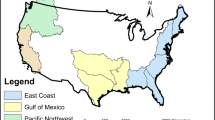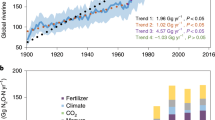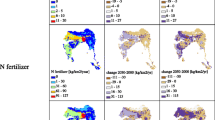Abstract
This paper provides a global synthesis of reactive nitrogen (Nr) loading to the continental landmass and subsequent riverine nitrogen fluxes under a gradient of anthropogenic disturbance, from pre-industrial to contemporary. A mass balance model of nitrogen loading to the landmass is employed to account for transfers of Nr between atmospheric input sources (as food and feed products) and subsequent consumer output loads. This calculation produces a gridded surface of nitrogen loading ultimately mobilizable to aquatic systems (Nmob). Compared to the pre-industrial condition, nitrogen loading to the landmass has doubled from 111 to 223 Tg/year due to anthropogenic activities. This is particularly evident in the industrialized areas of the globe where contemporary levels of nitrogen loading have increased up to 6-fold in many areas. The quantity of nitrogen loaded to the landscape has shifted from a chiefly fixation-based system (89% of total loads) in the pre-industrial state to a heterogeneous mix in contemporary times where fertilizer (15%), livestock (24%) and atmospheric deposition (15%) dominate in many parts of the industrialized and developing world. A nitrogen transport model is developed from a global database of drainage basin characteristics and a comprehensive compendium of river chemistry observations. The model utilizes constituent delivery coefficients based on basin temperature and hydraulic residence times in soils, rivers, lakes and reservoirs to transport nitrogen loads to river mouths. Fluxes are estimated for total nitrogen, dissolved inorganic nitrogen, and total organic nitrogen. Model results show that total nitrogen fluxes from river basins have doubled from 21 Tg/year in the pre-industrial to 40 Tg/year in the contemporary period, with many industrialized areas of the globe showing an increase up to 5-fold. DIN fluxes from river basins have increased 6-fold from 2.4 Tg/year in the pre-industrial to 14.5 Tg/year in the contemporary period. The amount of nitrogen loading delivered to river mouth as flux is greatly influenced by both basin temperatures and hydraulic residence times suggesting a regional sensitivity to loading. The global, aggregate nitrogen retention on the continental land mass is 82%, with a range of 0–100% for individual basins. We also present the first seasonal estimates of riverine nitrogen fluxes at the global scale based on monthly discharge as the primary driver.
Similar content being viewed by others
References
Alexander R.B., Slack J.R., Ludtke A.S., Fitzgerald K.K. and Schertz T.L. 1995. US Geological Survey National Stream Water-Quality Monitoring Networks (WQN), USGS Digital Data Series DDS-37.
Alexander R.B., Smith R.A. and Schwarz G.E. 2000. Effect of stream channel size on the delivery of nitrogen to the Gulf of Mexico. Nature 403(6771): 758–761.
Billen G. and Garnier J. 1999. Nitrogen transfers through the Seine drainage network: a budget based on the application of the ‘Riverstrahler’ model. Hydrobiologia 410: 139–150.
Bouwman A.F. and Boumans L.J.M. 2002. Estimation of Global NH3 volatilization loss from synthetic fertilizers and animal manure to arable lands and grasslands. Biogeochem. Cy. (in press).
Bouwman A.F., Lee D.S., Asman W.A.H., Dentener F.J., Van Der Hoek K.W. and Olivier J.G.J. 1997. A Global High-Resolution Emission Inventory for Ammonia. Global Biogeochemical Cycles 11(4): 561–587.
Boyer E.W., Goodale C.L., Jaworsk N.A. and Howarth R.W. 2002. Anthropogenic nitrogen sources and relationships to riverine nitrogen export in the northeastern USA. Biogeochemistry 57(1): 137–169.
Caraco N. and Cole J. 1999. Human impact on nitrate export: an analysis using major world rivers. Ambio 28: 167–170.
Cleveland C.C., Townsend A.R., Schimel D.S., Fisher H., Howarth R.W., Hedin L.O., Perakis S.S., Latty E.F., Von Fischer J.C., Elseroad A. and Wasson M.F. 1999. Global patterns of terrestrial biological nitrogen (N2 ) fixation in natural systems. Global Biogeochem. Cy. 13: 623–645.
Covich A.P. 1993. Water and ecosystems. In: Gleick P.H. (ed) Water in Crisis: A Guide to the World's Fresh Water Resources. Oxford University Press, Oxford, pp. 40–55.
Dentener F.J. and Crutzen P.J. 1994. A three dimensional model of the global ammonia cycle. J. Atmos. Chem. 19: 331–369.
Donner S.D., Coe M.T., Lenters J.D., Twine T.E. and Foley J.A. 2002. Modeling the impact of hydro-logical changes on nitrate transport in the Mississippi River Basin from 1955 to 1994. Global Bio-geochem. Cy. 16(3): 1043.
Elvidge C.D., Baugh K.E., Kihn E.A., Kroehl H.W. and Davis E.R. 1997. Mapping city lights with nighttime data from the DMSP operational linescan system. Photogrammetric Eng. Remote Sensing 63(6): 727–734.
(EDC) Earth Resources Observation Systems (EROS) Data Center 2000. Global Land Cover Char-acterization. EROS Data Center Distributed Active Archive Center. http://edcdaac.usgs.gov/.
Environmental Systems Research Institute, Inc. (ESRI) 1995. Arc World Supplement, 1:3 M scale digital map. Environmental Systems Research Institute, Inc., Redlands, CA.
Food and Agriculture Organization of the United Nations (FAO) 2001. FAOSTAT: FAO Statistical Databases. Accessible through the Food and Agriculture Organization of the United Nations. http:// apps.fao.org/.
Fekete B.M., Vörösmarty C.J. and Grabs W. 1999. Global, Composite Runoff Fields Based on Observed River Discharge and Simulated Water Balances. WMO-Global Runoff Data Center Report #22. Koblenz, Germany.
Fekete B.M., Vorosmarty C.J. and Grabs W. 2002. High-resolution fields of global runoff combining observed river discharge and simulated water balances. Global Biogeochem. Cy. 16(3): 1042.
Galloway J.N., Dentener F.J., Capone D.G., Boyer E.W., Howarth R.W., Seitzinger S.P., Asner G., Cleveland C., Green P.A., Holland E., Karl D.M., Michaels A.F., Porter J., Townsend A. and Vor-osmarty C.J. 2003. Global and regional nitrogen cycles: past, present and future. Biogeochemistry (submitted).
Goolsby D.A. and Battaglin W.A. 2001. Long-term changes in concentrations and flux of nitrogen in the Mississippi River Basin, USA. Hydrol. Process 15(7): 1209–1226.
Hession W.C., McBride M. and Bennett M. 2000. Statewide non-point-source pollution assessment methodology. J. Water Res. PL-ASCE 126(3): 146–155.
Hobbie J.E. (ed) 2000. Estuarine Science: A Synthetic Approach to Research and Practice. Island Press, Washington, DC, 539 pp.
Hopkinson C.S. and Vallino J.J. 1995. The relationships among mans activities in watersheds and estuaries - a model of runoff effects on patterns of estuarine community metabolism. Estuaries 18(4): 598–621.
Howarth R.W. 1998. An assessment of human influences on fluxes of nitrogen from the terrestrial landscape to the estuaries and continental shelves of the North Atlantic Ocean. Nutr. Cy. Agroecosyst. 52(2- 3): 213–223.
Howarth R.W., Billen G., Swaney D., Townsend A., Jaworski N., Lajtha K., Downing J.A., Elmgren R., Caraco N., Jordan T., Berendse F., Freney J., Kudeyarov V., Murdoch P. and Zhu Z.L. 1996. Regional nitrogen budgets and riverine N&P fluxes for the drainages to the North Atlantic Ocean: natural and human influences. Biogeochemistry 35(1): 75–139.
Howarth R.W., Boyer E.W., Pabich W.J., and Galloway J.N. 2002. Nitrogen use in the United States from 1961- 2000 and potential future trends. AMBIO 31(2): 88–96.
Jaworski N.A., Howarth R.W. and Hetling L.I. 1997. Atmospheric deposition of nitrogen oxides onto the landscape contributes to coastal eutrophication in the northeast United States. Environ. Sci. Technol. 31(7): 1995–2004.
Jordan T.E., Correll D.L. and Weller D.E. 1997. Nonpoint source discharges of nutrients from Piedmont watersheds of Chesapeake Bay. J. Am. Water Resour. As. 33(3): 631–645.
Justic D., Rabelais N.N., Turner R.E. and Dortch Q. 1995. Stoichiometric nutrient balance and origin of coastal eutrophication. Marine Pollut. Bull. 30: 41–46.
Kroeze C. and Seitzinger S.P. 1998. The impact of land use on N2O emissions from watersheds draining into the Northeastern Atlantic Ocean and European Seas. Environ. Pollut. 102(Suppl.): 149–158
Lerman A., Imboden D.M. and Gat J.R. 1995. Physics and Chemistry of Lakes. Springer-Verlag, Berlin and Heidelberg GmbH and Co. KG.
Lerner J., Matthews E. and Fung I. 1988. Methane emissions from animals: a global high-resolution data base. Global Biogeochem. Cy., 2: 139–156.
Leopold L.B., Wolman M.G. and Miller J.P. 1964. Fluvial Processes in Geomorphology. Freeman, NewYork.
Ludwig W. and Probst J.L. 1996. Predicting the oceanic input of organic carbon by continental erosion. Global Biogeochem. Cy. 10: 23–41.
Ludwig W. and Probst J.L. 1998. River sediment discharge to the oceans: present-day controls and global budgets. Am. J. Sci. 298: 265–295.
Mackenzie F.T., Ver L.M., Sabine C., Lane M. and Lerman A. 1993. C, N, P, S biogeochemical cycles and modeling of global change. In: Wollast R., Mackenzie T., Chou L. (eds) Interactions of C, N, P and S Biogeochemical Cycles and Global Change. NATO ASI Series I, 4, Springer-Verlag, New York, pp. 1–62.
McEvedy C. and Jones R. 1978. Atlas of World Population History. Penguin, New York.
Melillo J.M., McGuire A.D., Kicklighter D.W., Moore III B., Vö rösmarty C.J. and Schloss A.L. 1993. Global climate change and terrestrial net primary production. Nature 363: 234–240.
Meybeck M. 1993. Riverine transport of atmospheric carbon - sources, global typology and budget. Water Air Soil Pollut. 70(1- 4): 443–463.
Meybeck M. 1995. Global distribution of lakes. In: Lerman A. (ed) Physics and Chemistry of Lakes. Springer-Verlag, Berlin and Heidelberg GmbH and Co. KG.
Meybeck M. and Ragu A. 1995. River discharges to the Ocean: an assessment of suspended solids, major ions and nutrients. Laboratoire de Géologie Appliquée, Université P. et M. Curie, Paris, France.
Meybeck M. and Ragu A. 1997. River discharges to the oceans: an assessment of suspended solids, major ions, and nutrients. UNEP/WHO/GEMS-Water, 245 pp.
Meybeck M., Green P.A., and Vörösmarty C.J. 2001. A new typology for mountains and other relief classes. An application to global continental water resources and population distribution. Mountain Res. Dev. 21(1): 34–45.
National Assessment Synthesis Team 2001. Climate Change Impacts on the United States: The Potential Consequences of Climate Variability and Change. Report for the US Global Change Research Pro-gram, Cambridge University Press, Cambridge, UK. http://www.usgcrp.gov/ or http://www.cam-bridge. org/.
National Research Council (NRC) 1985. Nutrient Requirements of Domestic Animals Series. Committee on Animal Nutrition. National Academy Press, Washington, DC.
Organization for Economic Co-Operation and Development (OECD) 1999. OECD Environmental Data - Compendium 1999, OECD, Paris.
Peterson B.J., Wollheim W.M., Mulholland P.J., Webster J.R., Meyer J.L., Tank J.L., Marti E., Bowden W.B., Valett M., Hershey A.E., McDowell W.H., Dodds W.K., Hamilton S.K., Gregory S. and Morrall D.D. 2001. Control of nitrogen export from watersheds by headwater streams. Science 292: 86–90.
Pionke H.B., Gburek W.J., Schnabel R.R., Sharpley A.N., and Elwinger G.F. 1999. Seasonal flow, nu-trient concentrations and loading patterns in stream flow draining an agricultural hill-land watershed. J. Hydrol. 220(1- 2): 62–73.
Russell M.A., Walling D.E., Webb B.W. and Bearne R. 1998. The composition of nutrient fluxes from contrasting UK river basins. Hydrol. Process 12(9): 1461–1482.
Seitzinger S.P., Kroeze C., Bouwman A.F., Caraco N., Dentener F. and Stylkes R.V. 2002a. Global patterns of dissolved inorganic and particulate nitrogen inputs to coastal systems: recent conditions and future projections. Estuaries 25(4b): 640–655.
Seitzinger S.P., Styles R.V., Boyer E.W., Alexander R.B., Billen G., Howarth R.W., Mayer B. and van Breemen N. 2002b. Nitrogen retention in rivers: model development and application to watersheds in the northeastern USA. Biogeochemistry 57/58: 199–237.
Smil V. 1999. Nitrogen in crop production: an account of global flows. Global Biogeochem. Cy. 13: 647–662.
Steel E.W. and McGhee T.J. 1979. Water Supply and Sewerage. McGraw-Hill, New York.
Syvitski J.P., Morehead M.D., Bahr D.B. and Mulder T. 2000. Estimating fluvial sediment transport: the rating parameters. Water Resour. Res. 36(9): 2747–2760.
Turner R.E. and Rabelais N.N. 1994. Coastal eutrophication near the Mississippi river delta. Nature 368: 619–621
(UN-Habitat) United Nations Human Settlements Programme 2001. Global Urban Indicators Version 2 (Year of Reference - 1998). http://www.unhabitat.org/programmes/guo.
Van Dretch G., Bouwman A.F., Knoop J.M., Meinardi C. and Beusen A. 2001. Global pollution of surface waters from point and nonpoint sources of nitrogen. In: Optimizing Nitrogen Management in Food and Energy Production and Environmental Protection: Proceedings of the 2nd International Nitrogen Conference on Science Policy The Scientific World 1(S2), pp. 632–641.
Ver L.M., Mackenzie F.T. and Lerman A. 1999. Carbon cycle in the coastal zone: effects of global perturbations and change in the past three centuries. Chem. Geol. 159: 283–304.
Vörösmarty C.J. and Meybeck M. 2003. Responses of continental aquatic systems at the global scale: new paradigms, new methods. In: Kabat P., Claussen M., Dirmeyer P.A., Gash J.H.C., Bravo de Guenni L., Meybeck M., Pielke Sr. R.A., Vörösmarty C.J., Hutjes R.W.A. and Lutkemeier S. (eds) Vegetation, Water, Humans and the Climate. IGBP BAHC, Potsdam, Germany, pp. 517–572.
Vörösmarty C.J. and Peterson B.J. 2000. Macro-scale models of water and nutrient flux to the coastal zone. In: Hobbie J.E. (ed) Estuarine Science: A Synthetic Approach to Research and Practice. Island Press, Washington, DC.
Vörösmarty C.J., Federer C.A. and Schloss A.L. 1998. Evaporation functions compared on US water-sheds: Possible implications for global-scale water balance and terrestrial ecosystem modeling. J. Hydrol. 207(3- 4): 147–169.
Vörösmarty C.J., Fekete B.M., Meybeck M. and Lammers R.B. 2000a. Global system of rivers: its role in organizing continental landmass and defining land-to-ocean linkages. Global Biogeochem. Cy. 14(2): 599–621.
Vörösmarty C.J., Fekete B.M., Meybeck M. and Lammers R.B. 2000b. Geomorphometric attributes of the global system of rivers at 30-minute spatial resolution. J. Hydrol. 237(1- 2): 17–39.
Vörösmarty C.J., Green P.A., Salisbury J. and Lammers R.B. 2000c. Global water resources: vulner-ability from climate change and population growth. Science 289: 284–288.
Wollheim W.M., Peterson B.J., Deegan L.A., Hobbie J.E., Hooker B., Bowden W.B., Edwardson K.J., Arscott D.B., Hershey A.E. and Finlay J. 2001. Influence of stream size on ammonium and suspended particulate nitrogen processing. Limnol. Oceanogr. 46(1): 1–13.
World Resources Institute (WRI) 1998. World Resources: A Guide to the Global Environment 1998- 1999. World Resources Institute, Washington, DC.
Author information
Authors and Affiliations
Rights and permissions
About this article
Cite this article
Green, P.A., Vörösmarty, C.J., Meybeck, M. et al. Pre-industrial and contemporary fluxes of nitrogen through rivers: a global assessment based on typology. Biogeochemistry 68, 71–105 (2004). https://doi.org/10.1023/B:BIOG.0000025742.82155.92
Issue Date:
DOI: https://doi.org/10.1023/B:BIOG.0000025742.82155.92




